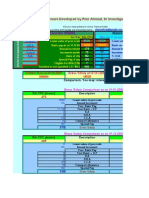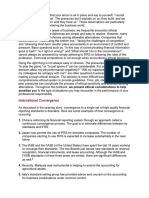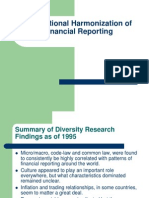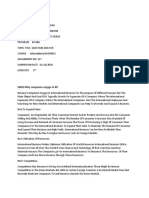Managing Globally
Managing Globally
Uploaded by
Prof. Lakshman MadurasingheCopyright:
Available Formats
Managing Globally
Managing Globally
Uploaded by
Prof. Lakshman MadurasingheOriginal Description:
Copyright
Available Formats
Share this document
Did you find this document useful?
Is this content inappropriate?
Copyright:
Available Formats
Managing Globally
Managing Globally
Uploaded by
Prof. Lakshman MadurasingheCopyright:
Available Formats
Managing Globally
4.1
Learning Objectives
After reading this chapter, you should be able to:
State several characteristics of the global economy Describe six strategies used by organizations in international business Explain the impact of political-legal forces on international business Discuss how three major trade agreements affect global competition
Describe how a countrys culture can affect an organizations
business practices
4.2
Global Economic Trends
Increased competition Shortened product life-cycles Importance of exports and imports Worldwide communication New countries emerge Borderless organizations Worldwide labor pool
Adapted from Table 4.1
4.3
Strategies for International Operations
High Global
C o m p l e x i t y
Low
Multidomestic
Franchising Alliances
Licensing
Exporting
Low
Resource Commitment
High
Adapted from Figure 4.1
4.4
Assessing Political Risk
Low
Domestic Instability Foreign Conflict Political Climate
Stable Low
High
High
Stable
Unstable
Economic Climate
Unstable Corrupt
Corruption
Noncorrupt
Adapted from Figure 4.2
4.5
Goals of the World Trade Organization (WTO)
Administer WTO trade agreements
Provide a forum for trade negotiations
Handle trade disputes between nations Monitor national trade policies Provide technical assistance and training for people in developing countries Cooperate with other international organizations
4.6
Goals of NAFTA
Create a U.S., Canadian,
and Mexican trade zone
Promote liberalized trade, not free trade Retain some protectionist elements Increase efficiency and customer satisfaction
4.7
Goals of the European Union
Create a single market among the 15 member countries
Eliminate existing barriers between countries Implement the Euro as a common currency
4.8
Tendencies of Many U.S. and Japanese Organizations
Dimensions Many (Not All) Major U.S. Organizations
Short term on average, but varies widely; unstable and insecure
Merit pay based on individual contribution; rapid promotion in career Individual responsibilities
Many (Not All) Major Japanese Organizations
Long-term for males (recent decline in lifetime employment), moderately secure and stable
Seniority-based early in career; more merit pay later Collective responsibilities; group loyalty, duty-oriented
Employment
Salary and promotion Attitude toward work
Adapted from Table 4.3
4.9
Tendencies of Many U.S. and Japanese Organizations (cont.)
Dimensions Many (Not All) Major U.S. Organizations
Individual-oriented; relatively top-down emphasis Depersonalized; emphasis on formal contacts Relatively free and open among individuals
Many (Not All) Major Japanese Organizations
Consultation oriented; bottom-up emphasis Personalized; employee treated more as a family member; paternalism Low among individuals within groups; high among groups
Decision making
Relationship with employees Competition
Adapted from Table 4.3
You might also like
- 6th Central Pay Commission Salary Calculator100% (436)6th Central Pay Commission Salary Calculator15 pages
- Class 9 Computer Book Federal Board Merged50% (4)Class 9 Computer Book Federal Board Merged120 pages
- Identifying and Analyzing Domestic and International Opportunities0% (1)Identifying and Analyzing Domestic and International Opportunities30 pages
- Chapter 4 Introduction To Management PearsoNo ratings yetChapter 4 Introduction To Management Pearso3 pages
- Chapter 2: Development and Classification: International Accounting, 7/eNo ratings yetChapter 2: Development and Classification: International Accounting, 7/e14 pages
- PEST Analysis Method and Examples, With Free PEST TemplateNo ratings yetPEST Analysis Method and Examples, With Free PEST Template19 pages
- Intermediate Accounting IFRS 3rd Edition-43-62No ratings yetIntermediate Accounting IFRS 3rd Edition-43-6220 pages
- International Harmonization of Financial Reporting100% (1)International Harmonization of Financial Reporting37 pages
- General Management - Managing in A Global EnvironmentNo ratings yetGeneral Management - Managing in A Global Environment22 pages
- International Business Finance: Differences Between Domestic and International Financial ManagementNo ratings yetInternational Business Finance: Differences Between Domestic and International Financial Management6 pages
- Financial Sector Reform: Discussion On Bekaert, Harvey and Lundblad Galindo and MiccoNo ratings yetFinancial Sector Reform: Discussion On Bekaert, Harvey and Lundblad Galindo and Micco25 pages
- Teach Yourself About Shares: A Self-help Guide to Successful Share InvestingFrom EverandTeach Yourself About Shares: A Self-help Guide to Successful Share InvestingNo ratings yet
- MBOT Director Application Form - Oct 2011No ratings yetMBOT Director Application Form - Oct 20114 pages
- IBM Questions From Previous VTU Question PapersNo ratings yetIBM Questions From Previous VTU Question Papers8 pages
- What Shares Should I Buy (Important Pe Vs MKTG)No ratings yetWhat Shares Should I Buy (Important Pe Vs MKTG)35 pages
- "The World Economy Is Globalizing at An Accelerating Pace". Discuss This Statement and List The Benefits of Globalization AnsNo ratings yet"The World Economy Is Globalizing at An Accelerating Pace". Discuss This Statement and List The Benefits of Globalization Ans10 pages
- Succeeding at Business in Southeast Asia: Common Mistakes Companies MakeFrom EverandSucceeding at Business in Southeast Asia: Common Mistakes Companies MakeNo ratings yet
- Managing in A Global Environment: Learning ObjectivesNo ratings yetManaging in A Global Environment: Learning Objectives27 pages
- 1-International Financial Market and EnvironmentNo ratings yet1-International Financial Market and Environment6 pages
- Management: Managing in A Global EnvironmentNo ratings yetManagement: Managing in A Global Environment17 pages
- Managing in A Global Environment: Instructor: Zhengxin Lingnan College, Sun Yat-Sen UniversityNo ratings yetManaging in A Global Environment: Instructor: Zhengxin Lingnan College, Sun Yat-Sen University26 pages
- ETH600 - Business Ethics - UNIT IX - Ethical Issues in International BusinessNo ratings yetETH600 - Business Ethics - UNIT IX - Ethical Issues in International Business48 pages
- Repec - How Much Do Trading Partners Matter For Economic GrowthNo ratings yetRepec - How Much Do Trading Partners Matter For Economic Growth21 pages
- International Financial Reporting Standards (IFRS) TransitionNo ratings yetInternational Financial Reporting Standards (IFRS) Transition44 pages
- An in Depth Inquiry Into E-Consciousness - Fabrics of Transformation100% (1)An in Depth Inquiry Into E-Consciousness - Fabrics of Transformation44 pages
- Institute of Theological Studies, Usa School of Ministry, GulfNo ratings yetInstitute of Theological Studies, Usa School of Ministry, Gulf36 pages
- Creativity and Problem Solving Using Conscious and Subconscious MindNo ratings yetCreativity and Problem Solving Using Conscious and Subconscious Mind156 pages
- Lattkatilaka (2) 292 Lanka Vatara Sutra: LANKAVATARA SUTRA, 'Discourse About 'EnterNo ratings yetLattkatilaka (2) 292 Lanka Vatara Sutra: LANKAVATARA SUTRA, 'Discourse About 'Enter7 pages
- Vapor-Liquid Equilibrium in Methyl Ethyl Ketone KetazineNo ratings yetVapor-Liquid Equilibrium in Methyl Ethyl Ketone Ketazine2 pages
- Porter's Generic Strategies: Cost Leadership DifferentiationNo ratings yetPorter's Generic Strategies: Cost Leadership Differentiation5 pages
- Automated Solar Powered Seed Sowing Machine: Project Reference No.:39S - Be - 0598No ratings yetAutomated Solar Powered Seed Sowing Machine: Project Reference No.:39S - Be - 05983 pages
- Download Complete Java Database Best Practices 1st Edition George Reese PDF for All Chapters100% (4)Download Complete Java Database Best Practices 1st Edition George Reese PDF for All Chapters51 pages
- The History of Online Dating From 1695 To Now - The Huffington PostNo ratings yetThe History of Online Dating From 1695 To Now - The Huffington Post4 pages
- Vimal Kishor Shah and Ors Vs Jayesh Dinesh Shah anSC20162208161317411COM189691No ratings yetVimal Kishor Shah and Ors Vs Jayesh Dinesh Shah anSC20162208161317411COM18969116 pages
- 2023 Level II Key Facts and Formula Sheet (KFFS)No ratings yet2023 Level II Key Facts and Formula Sheet (KFFS)14 pages
- CORAZON KO v. VIRGINIA DY ARAMBURO GR No. 190995, Aug 09, 2017 Co-Ownership, Sale, Void vs. Voidable Sale, Prescription - PINAY JURISTNo ratings yetCORAZON KO v. VIRGINIA DY ARAMBURO GR No. 190995, Aug 09, 2017 Co-Ownership, Sale, Void vs. Voidable Sale, Prescription - PINAY JURIST6 pages
- Identifying and Analyzing Domestic and International OpportunitiesIdentifying and Analyzing Domestic and International Opportunities
- Chapter 2: Development and Classification: International Accounting, 7/eChapter 2: Development and Classification: International Accounting, 7/e
- PEST Analysis Method and Examples, With Free PEST TemplatePEST Analysis Method and Examples, With Free PEST Template
- International Harmonization of Financial ReportingInternational Harmonization of Financial Reporting
- General Management - Managing in A Global EnvironmentGeneral Management - Managing in A Global Environment
- International Business Finance: Differences Between Domestic and International Financial ManagementInternational Business Finance: Differences Between Domestic and International Financial Management
- Financial Sector Reform: Discussion On Bekaert, Harvey and Lundblad Galindo and MiccoFinancial Sector Reform: Discussion On Bekaert, Harvey and Lundblad Galindo and Micco
- Teach Yourself About Shares: A Self-help Guide to Successful Share InvestingFrom EverandTeach Yourself About Shares: A Self-help Guide to Successful Share Investing
- "The World Economy Is Globalizing at An Accelerating Pace". Discuss This Statement and List The Benefits of Globalization Ans"The World Economy Is Globalizing at An Accelerating Pace". Discuss This Statement and List The Benefits of Globalization Ans
- Succeeding at Business in Southeast Asia: Common Mistakes Companies MakeFrom EverandSucceeding at Business in Southeast Asia: Common Mistakes Companies Make
- Managing in A Global Environment: Learning ObjectivesManaging in A Global Environment: Learning Objectives
- Managing in A Global Environment: Instructor: Zhengxin Lingnan College, Sun Yat-Sen UniversityManaging in A Global Environment: Instructor: Zhengxin Lingnan College, Sun Yat-Sen University
- ETH600 - Business Ethics - UNIT IX - Ethical Issues in International BusinessETH600 - Business Ethics - UNIT IX - Ethical Issues in International Business
- Trading Binary Options: Strategies and TacticsFrom EverandTrading Binary Options: Strategies and Tactics
- Repec - How Much Do Trading Partners Matter For Economic GrowthRepec - How Much Do Trading Partners Matter For Economic Growth
- International Financial Reporting Standards (IFRS) TransitionInternational Financial Reporting Standards (IFRS) Transition
- An in Depth Inquiry Into E-Consciousness - Fabrics of TransformationAn in Depth Inquiry Into E-Consciousness - Fabrics of Transformation
- Institute of Theological Studies, Usa School of Ministry, GulfInstitute of Theological Studies, Usa School of Ministry, Gulf
- Creativity and Problem Solving Using Conscious and Subconscious MindCreativity and Problem Solving Using Conscious and Subconscious Mind
- Lattkatilaka (2) 292 Lanka Vatara Sutra: LANKAVATARA SUTRA, 'Discourse About 'EnterLattkatilaka (2) 292 Lanka Vatara Sutra: LANKAVATARA SUTRA, 'Discourse About 'Enter
- Vapor-Liquid Equilibrium in Methyl Ethyl Ketone KetazineVapor-Liquid Equilibrium in Methyl Ethyl Ketone Ketazine
- Porter's Generic Strategies: Cost Leadership DifferentiationPorter's Generic Strategies: Cost Leadership Differentiation
- Automated Solar Powered Seed Sowing Machine: Project Reference No.:39S - Be - 0598Automated Solar Powered Seed Sowing Machine: Project Reference No.:39S - Be - 0598
- Download Complete Java Database Best Practices 1st Edition George Reese PDF for All ChaptersDownload Complete Java Database Best Practices 1st Edition George Reese PDF for All Chapters
- The History of Online Dating From 1695 To Now - The Huffington PostThe History of Online Dating From 1695 To Now - The Huffington Post
- Vimal Kishor Shah and Ors Vs Jayesh Dinesh Shah anSC20162208161317411COM189691Vimal Kishor Shah and Ors Vs Jayesh Dinesh Shah anSC20162208161317411COM189691
- CORAZON KO v. VIRGINIA DY ARAMBURO GR No. 190995, Aug 09, 2017 Co-Ownership, Sale, Void vs. Voidable Sale, Prescription - PINAY JURISTCORAZON KO v. VIRGINIA DY ARAMBURO GR No. 190995, Aug 09, 2017 Co-Ownership, Sale, Void vs. Voidable Sale, Prescription - PINAY JURIST













































































































